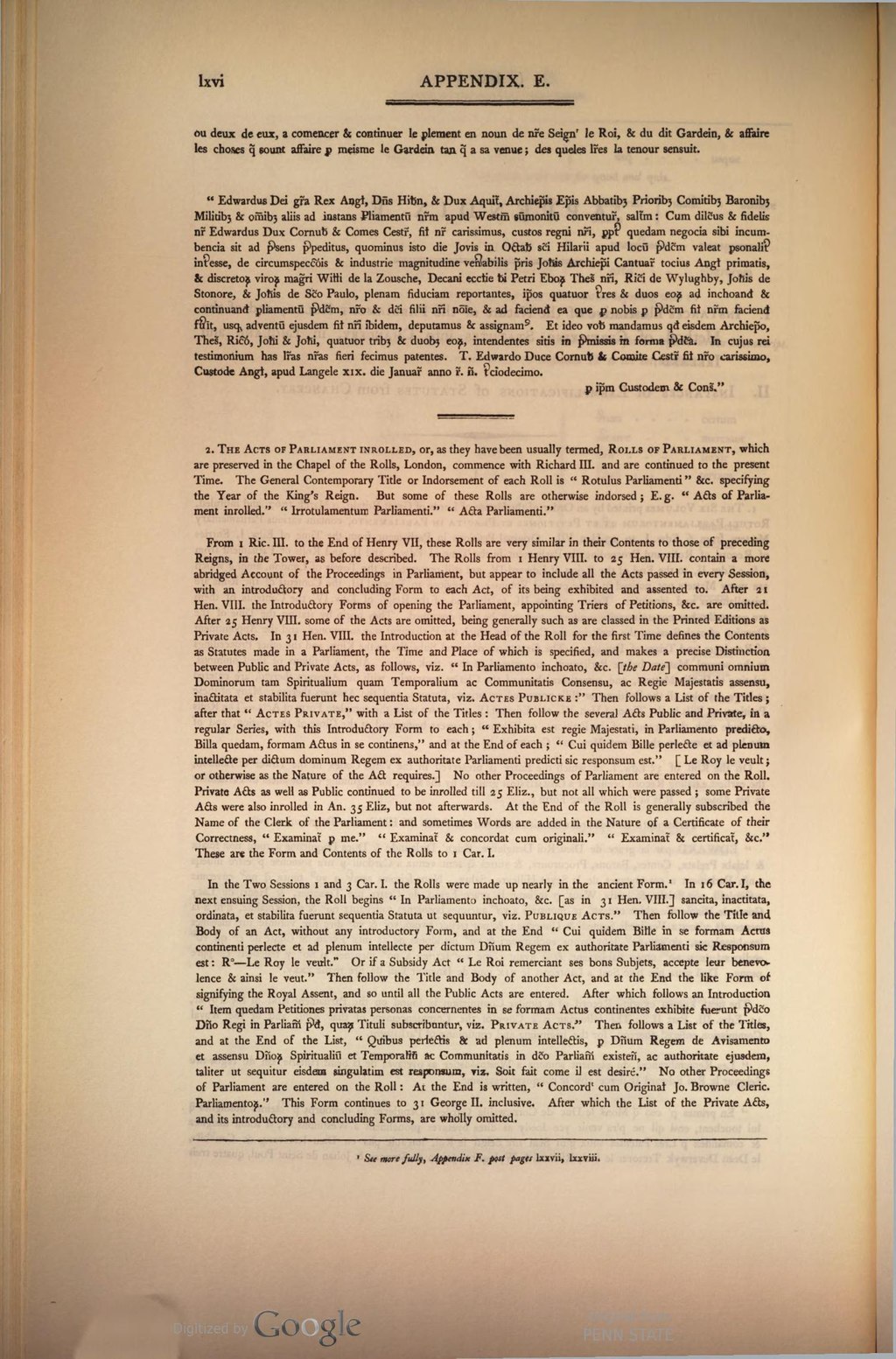“Edwardus Dei gr̃a Rex Angl̵, Dn̄s Hib̴n, & Dux Aquit̃, Archiep̃is Ep̃is Abbatibꝫ Prioribꝫ Comitibꝫ Baronibꝫ Militibꝫ & om̄ibꝫ aliis ad instans Ꝑliamentū nr̃m apud Westm̄ sūmonitū conventur̃, salt̃m: Cum dilc̃us & fidelis nr̃ Edwardus Dux Cornub̴ & Comes Cestr̃, fil̵ nr̃ carissimus, custos regni nr̃i, ꝑpt͛ quedam negocia sibi incumbencia sit ad p͛sens p͛peditus, quominus isto die Jovis in Octab̴ sc̃i Hilarii apud locū p͛dc̃m valeat ꝑsonalit͛ int͛esse, de circumspecc͠ois & industrie magnitudine ven͛abilis p̃ris Joh̴is Archiep̃i Cantuar̃ tocius Angl̵ primatis, & discretoꝝ viroꝝ mag̃ri Wil̴l̴i de la Zousche, Decani eccl̵ie b̴i Petri Eboꝝ Thes̃ nr̃i, Ric̃i de Wylughby, Joh̴is de Stonore, & Joh̴is de Sc̃o Paulo, plenam fiduciam reportantes, ip̃os quatuor t͛res & duos eoꝝ ad inchoand̵ & continuand̵ ꝑliamentū p͛dc̃m, nr̃o & dc̃i filii nr̃i nōīe, & ad faciend̵ ea que ꝓ nobis ꝑ p͛dc̃m fil̵ nr̃m faciend̵ fu͛īt, usqꝫ adventū ejusdem fil̵ nr̃i ibidem, deputamus & assignamꝰ. Et ideo vob̴ mandamus qd̵ eisdem Archiep̃o, Thes̃, Ric͠o, Joh̴i & Joh̴i, quatuor tribꝫ & duobꝫ eoꝝ, intendentes sitis in p͛missis in forma p͛dc̃a. In cujus rei testimonium has lr̃as nr̃as fieri fecimus patentes. T. Edwardo Duce Cornub̴ & Comite Cestr̃ fil̵ nr̃o carissimo, Custode Angl̵, apud Langele xix. die Januar̃ anno r̃. ñ. t͛ciodecimo.
ꝑ ip̃m Custodem & Cons̃.”
2. The Acts of Parliament inrolled, or, as they have been usually termed, Rolls of Parliament, which are preserved in the Chapel of the Rolls, London, commence with Richard III. and are continued to the present Time. The General Contemporary Title or Indorsement of each Roll is “Rotulus Parliamenti” &c. specifying the Year of the King’s Reign. But some of these Rolls are otherwise indorsed; E. g. “Acts of Parliament inrolled.” “Irrotulamentum Parliamenti.” “Acta Parliamenti.”
From 1 Ric. III. to the End of Henry VII, these Rolls are very similar in their Contents to those of preceding Reigns, in the Tower, as before described. The Rolls from 1 Henry VIII. to 25 Hen. VIII. contain a more abridged Account of the Proceedings in Parliament, but appear to include all the Acts passed in every Session, with an introductory and concluding Form to each Act, of its being exhibited and assented to. After 21 Hen. VIII. the Introductory Forms of opening the Parliament, appointing Triers of Petitions, &c. are omitted. After 25 Henry VIII. some of the Acts are omitted, being generally such as are classed in the Printed Editions as Private Acts. In 31 Hen. VIII. the Introduction at the Head of the Roll for the first Time defines the Contents as Statutes made in a Parliament, the Time and Place of which is specified, and makes a precise Distinction between Public and Private Acts, as follows, viz. “In Parliamento inchoato, &c. [the Date] communi omnium Dominorum tam Spiritualium quam Temporalium ac Communitatis Consensu, ac Regie Majestatis assensu, inactitata et stabilita fuerunt hec sequentia Statuta, viz. Actes Publicke:” Then follows a List of the Titles; after that “Actes Private,” with a List of the Titles: Then follow the several Acts Public and Private, in a regular Series, with this Introductory Form to each; “Exhibita est regie Majestati, in Parliamento predicto, Billa quedam, formam Actus in se continens,” and at the End of each; “Cui quidem Bille perlecte et ad plenum intellecte per dictum dominum Regem ex authoritate Parliamenti predicti sic responsum est.” [Le Roy le veult; or otherwise as the Nature of the Act requires.] No other Proceedings of Parliament are entered on the Roll. Private Acts as well as Public continued to be inrolled till 25 Eliz., but not all which were passed; some Private Acts were also inrolled in An. 35 Eliz, but not afterwards. At the End of the Roll is generally subscribed the Name of the Clerk of the Parliament: and sometimes Words are added in the Nature of a Certificate of their Correctness, “Examinat̃ ꝑ me.” “Examinat̃ & concordat cum originali.” “Examinat̃ & certificat̃, &c.” These are the Form and Contents of the Rolls to 1 Car. I.
In the Two Sessions 1 and 3 Car. I. the Rolls were made up nearly in the ancient Form.[1] In 16 Car. I, the next ensuing Session, the Roll begins “In Parliamento inchoato, &c. [as in 31 Hen. VIII.] sancita, inactitata, ordinata, et stabilita fuerunt sequentia Statuta ut sequuntur, viz. Publique Acts.” Then follow the Title and Body of an Act, without any introductory Form, and at the End “Cui quidem Bille in se formam Actus continenti perlecte et ad plenum intellecte per dictum Dñum Regem ex authoritate Parliamenti sic Responsum est: R°—Le Roy le veult.” Or if a Subsidy Act “Le Roi remerciant ses bons Subjets, accepte leur benevolence & ainsi le veut.” Then follow the Title and Body of another Act, and at the End the like Form of signifying the Royal Assent, and so until all the Public Acts are entered. After which follows an Introduction “Item quedam Petitiones privatas personas concernentes in se formam Actus continentes exhibite fuerunt p͛dc̃o Dño Regi in Parliam̃ p͛d̵, quaꝝ Tituli subscribuntur, viz. Private Acts.” Then follows a List of the Titles, and at the End of the List, “Quibus perlectis & ad plenum intellectis, ꝑ Dñum Regem de Avisamento et assensu Dñoꝝ Spiritualiū et Temporaliū ac Communitatis in dc̃o Parliam̃ existeñ, ac authoritate ejusdem, taliter ut sequitur eisdem singulatim est responsum, viz. Soit fait come il est desire͏́.” No other Proceedings of Parliament are entered on the Roll: At the End is written, “Concordt cum Original̵ Jo. Browne Cleric. Parliamentoꝝ.” This Form continues to 31 George II. inclusive. After which the List of the Private Acts, and its introductory and concluding Forms, are wholly omitted.
- ↑ See more fully, Appendix F. post pages lxxvii, lxxviii.
